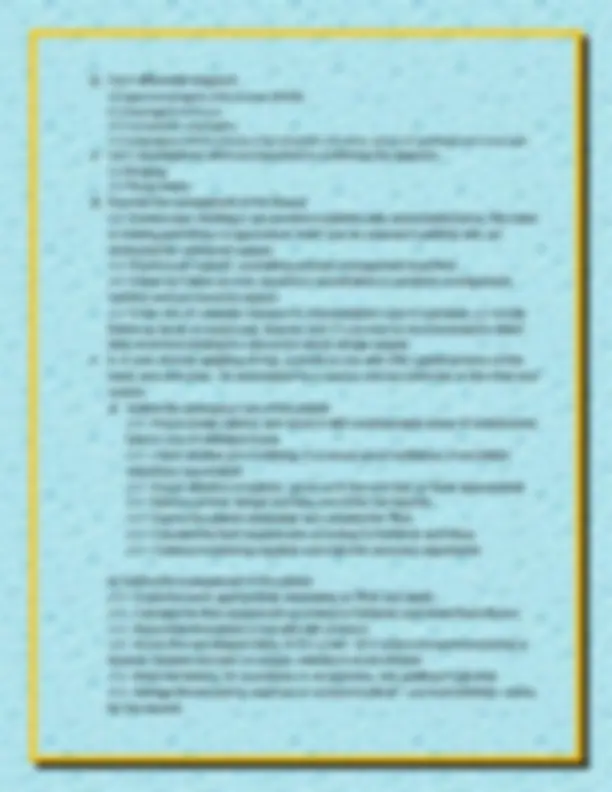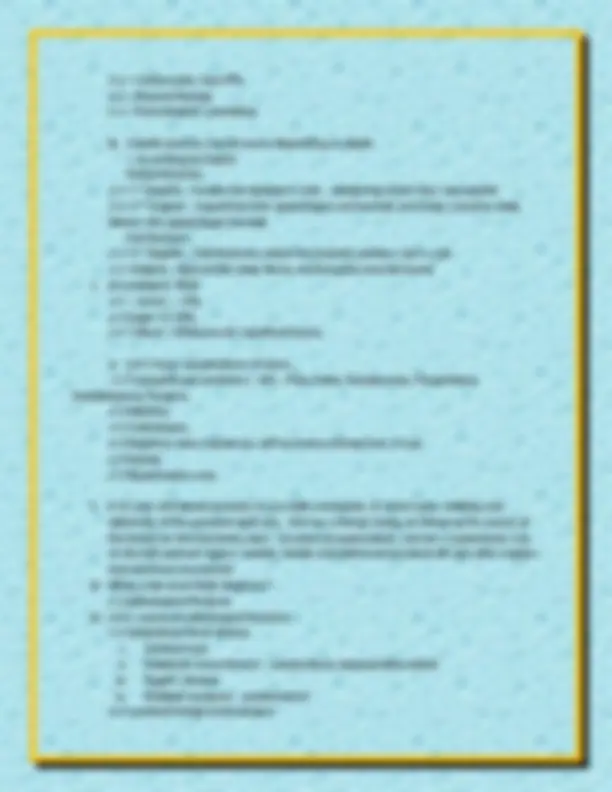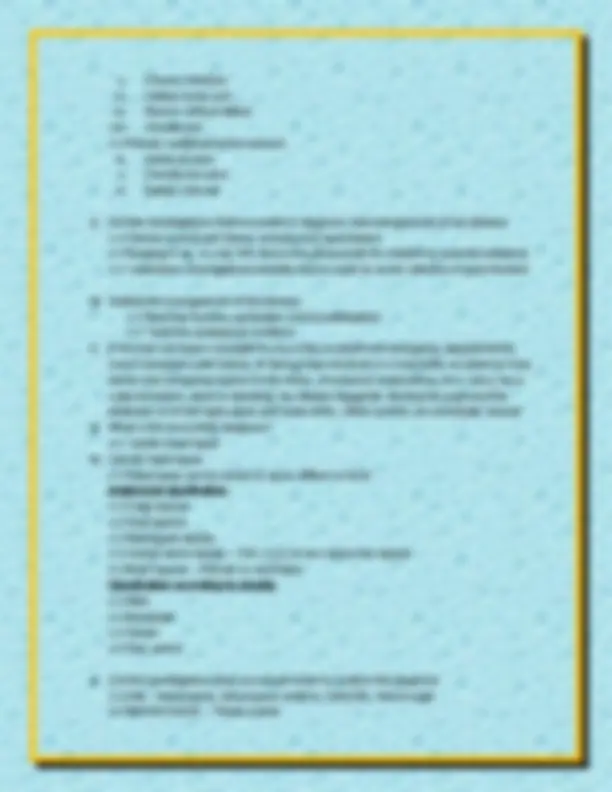Download SURGERY REVISION SESSION QUESTIONS and more Exercises General Surgery in PDF only on Docsity!
SURGERY REVISION SESSION QUESTIONS
- A 30 year old man, who is known alcoholic presents to you in accident and emergency department with complaints of severe haematemesis: a) Define haematemesis ✔✔refers to vomiting blood. b) List 4 possible causes of haematemesis in the above patient ✔✔pud, ✔✔Gastroduodenal erosions, ✔✔Oesophagitis ✔✔Oesophageal varices ✔✔'Mallory-Weiss' tears ✔✔Upper gastrointestinal malignancy ✔✔Vascular malformations c) List 5 investigations which are useful in confirming the diagnosis ✔✔Labs – CBC, LFTs, UEC, Coagulation studies ✔✔OGD ✔✔CXR: - May identify aspiration pneumonia - Pleural effusion - Perforated oesophagus ✔✔Erect and supine abdominal X ray to exclude perforated viscus and ileus ✔✔CT scan and ultrasound can identify: - Liver disease - Cholecystitis with haemorrhage - Pancreatitis with haemorrhage and pseudocyst - Aortoenteric fistulae
- Question: Kelvin, a 35 years old male presents to you in the outpatient department complaining of acute abdominal pain, vomiting, abdominal distention and constipation. On examination, He was sick looking, febrile and dehydrated. He has abdominal guarding, rebound tenderness and reduced bowel sounds on auscultation. a) What is the most likely diagnosis ✔✔Most likely diagnosis – Acute peritonitis with adynamic intestinal obstruction (paralytic ileus) b) Classify intestinal obstruction ✔✔Intestinal obstruction is classified as Mechanical or Paralytic ileus : ✔✔ Mechanical intestinal obstruction (Dynamic) – due to blockage of passage by a structural barrier ✔✔Small bowel obstruction – Partial or total; acute or chronic – usually due to adhesions, volvulus, intussusception, obstructed hernia ✔✔Large bowel obstruction – Partial or total; acute or chronic – usually due to malignancies, fecal impaction, volvulus
✔✔Paralytic ileus (adynamic) – Due to temporally impairment of peristalsis – usually due to peritonitis, hypokalaemia, bowel ischaemia, drugs like opiods, anticholinergics, antidepressants, pseudo-obstruction c)List three causes of dynamic intestinal obstruction
✔✔adhesions,
✔✔hernias,
✔✔ tumors, and
✔✔ inflammatory conditions.
d) List three investigations to confirm diagnosis Imaging – ✔✔ Plain abd-Xray (AP & Lat decubitus), ✔✔Abd Ultra sound scan, ✔✔ CT scan in difficulty diagnosis Labs – ✔✔UEC, ✔✔ CBC, ✔✔RBS, ✔✔ LFTs, ✔✔serum amylase/lipase d) Describe the management of Kelvin’s disease ✔✔Supportive (conservative) NBM NGT IV fluids Enema Parenteral Anaelgesic, antispasmodics Antibiotic cover ✔✔Surgery – Exploratory laparotomy – Intra-op management dependent on cause: in peritonitis – peritoneal lavage and repair of the perforation or removal of infected material/appendix
- A 75 year old male presents to you with complaints of progressive dysphagia for 6 months. The dysphagia is associated with regurgitation of the food a few minutes after eating. On physical examination, he is wasted, dehydrated, mildly pale, has no lymphadenopathy, not jaundice, abdomen is scaphoid and has no organomegally. a) What is the most likely diagnosis ✔✔Ca Esophagus-
✔✔– Control pain, Give PPIs ✔✔– Physical therapy ✔✔– Psychological counseling b) Classify primary classify burns depending on depth
- According to Depth: Partial thickness ✔✔– 1 st^ Degree – Involve the epidermis only – reddening of the skin, very painful ✔✔– 2 nd^ Degree – Superficial (skin appendages not burned) and Deep ( involves deep dermis skin appendages burned) Full thickness ✔✔– 3 rd^ Degree – Full thickness; entire skin burned, painless, has a scab ✔✔–Degree – Beyond the deep fascia, involving the muscles/bones
- According to TBSA ✔✔ – minor < 10%, ✔✔major 10-30%, ✔✔ Critical >30%burns for superficial burns; c) List 5 local complications of burns ✔✔Compartment syndrome – 6Ps – Pain, Pallor, Pulselessness, Paraesthesia, Poikilothermia, Paralysis ✔✔Infection ✔✔Contractures ✔✔Marjorins ulcer (squamous cell carcinoma arising from a scar) ✔✔Keloids ✔✔Hypertrophic scars
- A 65 year old female presents to you with complaints of severe pain, swelling and deformity of the proximal right arm. She has a history being on follow up for cancer of the breast for the last three years. On physical examination, she has a mastectomy scar on the left pectoral region, swollen, tender and deformed proximal left arm with crepitus and abnormal movement. a) What is the most likely diagnosis? ✔✔pathological fractures b) List 5 causes of pathological fractures ✔✔Generalised bone disease i. Osteoporosis ii. Metabolic bone disease - osteomalacia, hyperparathyroidism iii. Paget's disease iv. Multiple myeloma - myelomatosis ✔✔Localised benign bone disease
v. Chronic infection vi. Solitary bone cyst vii. Fibrous cortical defect viii. Chondroma ✔✔Primary malignant bone tumours ix. Osteosarcoma x. Chondrosarcoma xi. Ewing's tumour c) List the investigations that are useful in diagnosis and management of her disease. ✔✔Clinical assessment-history and physical examination ✔✔Imaging-x ray, ct scan, Mri, Bone scan,ultrasound( for children to prevent radiation) ✔✔ Laboratory investigation(complete blood count-to assess infection if open fracture d) Outline the management of the disease ✔✔Treat the fracture, eg fixation and immobilization ✔✔ Treat the underlying condition
- A 40-year-old male is brought to you in the accident and emergency department by Good Samaritans with history of having been involved in a road traffic accident an hour earlier and sustaining injuries to the head. On physical examination, he is coma, has a scalp laceration, which is bleeding, has dilated sluggishly reacting let pupil and the weakness of of the right upper and lower limbs. Other systems are essentially normal. a) What is the most likely diagnosis? ✔✔ Severe Head Injury b) Classify Head injury ✔✔Head injury can be closed or open; diffuse or focal Anatomical classification ✔✔Scalp injuries ✔✔Skull injuries ✔✔Meningeal injuries ✔✔Cranial nerve injuries – CN1,2,3,6,7,8 are commonly injured ✔✔Brain injuries – Primary or secondary Classification according to severity ✔✔Mild ✔✔Moderate ✔✔Severe ✔✔Very severe c) List the investigations that you would order to confirm the diagnosis ✔✔LAB - Haemogram, blood gases analysis, GXM,UEC, blood sugar ✔✔RADIOLOGICAL – Trauma series
✔✔IMAGING
1. CXR
- CXR most useful screening investigation
- Look for subcutaneous air, foreign bodies, bony fractures, widening of mediastinum, pneumothorax, pneumomediastinum, pleural fluid, pulmonary parenchymal abnormalities (infiltrates, atelectasis etc)
- CT Scan Valuable tool Aids in diagnosis and precise location of numerous lesions. Contrast is useful particularly when looking for mediastinal haemorrhage and periaortic haematomas.
- Echocardiography Cardiac wall motion abnormalities and valve function and presence of pericardial fluid or blood.
- ECG Most common abnormality in thoracic trauma are S-T and T wave changes and findings indicative of bundle branch block
- Angiography Remains the gold standard for defining thoracic vascular injuries
- Bronchoscopy Indications include evaluation of airway injury, haemoptysis, segmental or lobar collapse, and removal of aspirated foreign bodies. d) Describe the management of the patient. Immediate management ✔✔ Assure patent airway, oxygenation and ventilation ✔✔ Exclude or treat: pneumothorax – Insert chest tube and set an UWSD system haemothorax - Insert chest tube and set an UWSD system cardiac tamponade – requires urgent pericardiocentesis ✔✔ Assess for extrathoracic injuries ✔✔ Decompress stomach by nasogastric tube ✔✔ Provide pain relief especially for fractured ribs ✔✔ Reconsider endotracheal intubation, ventilation for hypoxic patients ✔✔ In particular take into account gross obesity, significant pre-existing lung disease, severe pulmonary contusion or aspiration, need for surgery for thoracic or extrathoracic injuries Chest drains Indications for insertion of chest drains/tube or under water seal drainage system (UWSDS)in stable patients are as follows: - Pneumothorax > 10% in non-ventilated patient (i.e. >1 intercostal space)
Haemothorax > 500 ml (i.e. above neck of 7th rib) Haemopneumothorax Surgical Emphysema Post operative – thoracotomy, oesophagectomy, cardiac surgery Malignant pleural effusion Massive pleural effusions
















